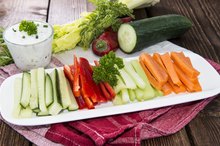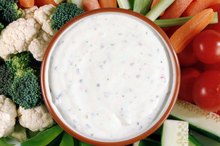Percentage of Daily Values Based on a 2000 Calorie Diet
A nutrition food label is a good tool to use to help you make healthy food choices. The percent daily value section on a food label provides FDA recommendations of key nutrients based on a 2,000-calorie diet plan. Even if you do not follow a 2,000-calorie diet, you can still use the percent daily value information to identify foods that are sources of nutrients you need to increase, and nutrients you need to limit.
Fat and Cholesterol
You can use the percentage of daily value on a food label to help you limit your intake of foods high in fat, saturated fat and cholesterol. When looking at a food label, if a food item contains more than 20 percent of your daily value for total fat, saturated fat or cholesterol it is considered high in these nutrients. On a 2,000-calorie diet, the recommended intake of total fat is 65 g, saturated fat is 20 g and cholesterol 300 mg per day. If a food contains 20 percent of your daily value for saturated fat, it contains 4 g of saturated fat per serving.
- You can use the percentage of daily value on a food label to help you limit your intake of foods high in fat, saturated fat and cholesterol.
- If a food contains 20 percent of your daily value for saturated fat, it contains 4 g of saturated fat per serving.
Sodium
How Many Calories in Carrot Sticks?
Learn More
You can also use the food label to help you limit your intake of sodium. The percent daily value for sodium on a 2,000-calorie diet is based on 2,400 mg of sodium a day. High intakes of sodium can increase your risk of high blood pressure. A food item containing 5 percent or less of your daily value is considered low in that nutrient.
- You can also use the food label to help you limit your intake of sodium.
- A food item containing 5 percent or less of your daily value is considered low in that nutrient.
Carbohydrates and Fiber
Food labels also provide the percent daily value for carbohydrates and fiber. The percent daily value for carbohydrates is based on a need of 300 g a day on a 2,000-calorie diet, and for fiber, 25 g a day. Including more high-fiber foods in your diet, those containing more than 20 percent of your daily value, can help lower blood cholesterol and help you manage your weight.
Vitamin A
Women's Body Sculpting Diet
Learn More
Most Americans do not get enough vitamin A in their diets, according to the FDA. Food labels are required to provide the percent daily value for vitamin A, which is based on the recommendation of 5,000 IU a day on a 2,000-calorie diet. Vitamin A supports growth and development and bone, eye and immune health.
Vitamin C
Vitamin C is also an essential nutrient most Americans lack in their diet. The percent daily value on a food label is based on a need of 60 mg a day. Vitamin C also supports normal growth and development, and is necessary for the proper formation of collagen, a structural protein found in your ligaments and skin. To increase your intake, look for foods with more than 20 percent daily value for vitamin C.
- Vitamin C is also an essential nutrient most Americans lack in their diet.
- Vitamin C also supports normal growth and development, and is necessary for the proper formation of collagen, a structural protein found in your ligaments and skin.
Calcium
Calcium is important for bone health. On a 2,000-calorie diet, the percent daily value for calcium is based on a need of 1,000 mg a day. If a food items provides 25 percent of your daily value for calcium it contains 250 mg of calcium per serving.
Iron
Iron is an essential nutrient necessary for the transportation of oxygen throughout your body. The percent daily value on a 2,000-calorie diet is based on a need of 18 mg of iron a day.
Related Articles
References
- Food and Drug Administration; How to Understand and Use the Nutrition Facts Label; June 2000
- Office of Dietary Supplements; Vitamin A; April 2006
- Office of Dietary Supplements; Iron; August 2007
- Office of Dietary Supplements; Vitamin C; November 2009
- Office of Dietary Supplements; Calcium; January 2011
- The New Nutrition Facts Label. U.S. Food and Drug Administration. Published June 18, 2019.
- Office of Disease Prevention and Health Promotion, Office of the Assistant Secretary for Health, Office of the Secretary, U.S. Department of Health and Human Services. Appendix 2. Estimated Calorie Needs per Day, by Age, Sex, and Physical Activity Level - 2015-2020 Dietary Guidelines. 2019.
- Levy L, Patterson R, Kristal A, Li S. How Well Do Consumers Understand Percentage Daily Value on Food Labels?. American Journal of Health Promotion. 2000;14(3):157-160. doi:10.4278/0890-1171-14.3.157
- Levy L, Patterson RE, Kristal AR, Li SS. How Well Do Consumers Understand Percentage Daily Value on Food Labels? American Journal of Health Promotion. 2000;14(3):157-160. doi:10.4278/0890-1171-14.3.157.
- Center for Food Safety and Applied Nutrition. How to Understand and Use the Nutrition Facts Label. U.S. Food and Drug Administration. https://www.fda.gov/food/nutrition-education-resources-materials/how-understand-and-use-nutrition-facts-label. Published 2019.
- Ingels JS, Misra R, Stewart J, Lucke-Wold B, Shawley-Brzoska S. The Effect of Adherence to Dietary Tracking on Weight Loss: Using HLM to Model Weight Loss over Time. J Diabetes Res. 2017;2017:6951495. doi:10.1155/2017/6951495
- National Institutes of Health. Daily value reference of the dietary supplement label database (DSLD).
- U. S. Food and Drug Administration. Nutrition facts label.
- US Food and Drug Administration. Changes to the Nutrition Facts Label.
- US Food and Drug Administration. How to understand and use the nutrition facts label.
Writer Bio
Jill Corleone is a registered dietitian and health coach who has been writing and lecturing on diet and health for more than 15 years. Her work has been featured on the Huffington Post, Diabetes Self-Management and in the book "Noninvasive Mechanical Ventilation," edited by John R. Bach, M.D. Corleone holds a Bachelor of Science in nutrition.









